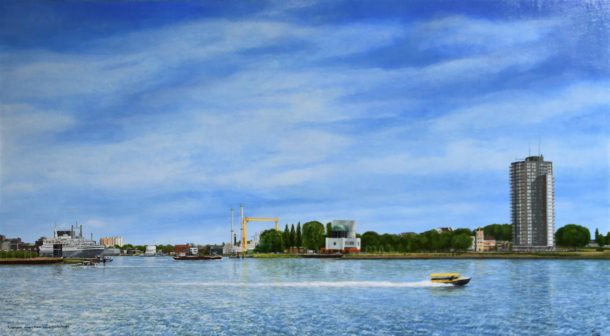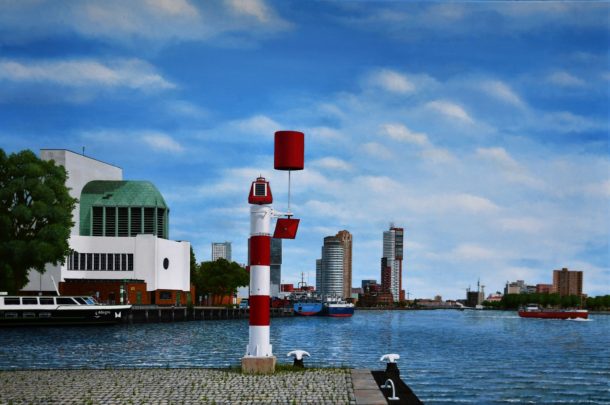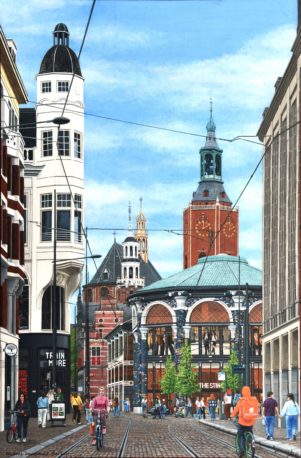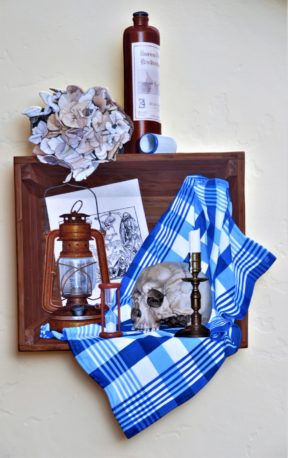World Fine Art Professionals and their Key-Pieces, 488 - Hans de Heus
World Fine Art Professionals and their Key-Pieces, 488 – Hans de Heus
In the Hague Art Circle (Haagse Kunstkring) I saw very realistic paintings by Hans de Heus. Of well-known cityscapes in Rotterdam and The Hague in particular. They looked like photographs. In addition, special trompe l’oeil still lifes, sometimes in the form of cabinets.
At his exhibition I saw him working on a still life of a whisky bottle. Hans de Heus has a beard as big as Claude Monet, but a little better groomed. About ten days later I visit him in one of the side streets of the Heemraadsingel in Rotterdam.
Drawing outside
On the wall I see the cityscapes, including the Maas from the Müllerpier with the red and white pole, once as a drawing and, above it, in acrylic; the Ode to Auke de Vries: a harbour view from under the Meusebridge (Maasbrug); the north aisle of the Laurens church (Laurenskerk) Rotterdam, it looks like a Saenredam and a Momento mori still life with a skull, a candle, an hourglass and an engraving of the Last Judgement. In front of it are three easels, the left one of which belongs to a pupil. I see a drawing and a new work in progress: the Rotterdam station.
In addition to cityscapes and (trompe l’oeil) still lifes, he also makes harbour views and self-portraits, he says. He draws a lot outside. He has two chairs with him. A folding chair to sit on and a chair that, with a plank on it, serves as a material table. “Yesterday I went to sketch the Depot.” The Depot is next to the Museum Boijmans Van Beuningen in the Museumpark in Rotterdam. It is a very special building. A half egg shape with mirrored glass on the outside in which the entire park-like environment is reflected. “It will be an acrylic painting. It is a difficult construction.”
He usually makes an A3 drawing or a watercolour. He draws with pencil on tinted paper. “That way you have less reflection. You can ‘heighten’ it with white.”
Calligraphy
He also did a lot of calligraphy, especially between 1980 and 2006. He mainly made miniatures. He recorded the entire Beatrijs, the story of the Conickskinderen and the Walewein using medieval techniques. He wrote about it and gave workshops and lectures about it. The bookcase behind me is full of books about medieval miniatures and calligraphy. “It quickly becomes a mania for me.” In another bookcase are the hardcover holiday books in which he records the experiences also in calligraphy, with drawings and maps. I see beautiful pictures of Ravenna. “At the end of the holiday day I was working on it. I already did it at the Academy.”
The impetus for his calligraphy (and comics and cartoons) was a serious car accident in 1983. He had to go to the hospital for major operations. “I was out of action for a year. I then started doing small things. I already had a focus on the Middle Ages. At the Academy I had been taught by Gerrit Noordzij, the famous type designer. That stimulated me to go for it completely. I also immersed myself in parchment and gold leaf. In addition, I made cartoons and comics for school reports. I thought I was completely cured, but it turned out that I had picked up a bacterium during the accident that landed me in the hospital for two or three weeks each time. In the period 1983-2017 I had to go to the hospital more than 12 times.”
Does Hans have a key work?
He does. “Five years ago I was working on cityscapes in Schiedam. While I was drawing a ship lock outside, I got talking to a young couple in their early thirties. Whether I could make a painting of the harbour from their window. I had never done a harbour view before. I went into their house and made my first harbour view from the window. A work of one metre by 60 cm. They loved it. I got the taste for it and never stopped making harbour views. ‘It’s your fault’, I told them.”
Dean
Hans was a drawing teacher at the Rotterdam Lebanon Lyceum for more than 40 years. In 1976 he graduated from the Royal Academy of Fine Arts in The Hague. He did the teacher training at that academy for five years, both first-degree and second-degree, because he needed an income. He taught four days a week and the rest of the week was for his own work. “I have always had something with children. I was active at the korfball club, training and coaching aspiring teams.” After teaching drawing for a few years, he also became dean of the HAVO (kind of highschool) in the eighties. Later, the MAVO was also added. “Then you help students choose their subject package. That usually happens in the third year. Once the choice has been made, you guide them further to a follow-up education. If they get stuck, I advise them what to do. I had a lot of contact with students and parents.”
What is his experience of the art world?
“I have kept myself relatively out of the art world. I was busy with school and family. I have exhibited, but mainly in groups. After 20 years, my ‘class’ from the Art Academy got together again. After that, we kept in touch. In 2018, we organized a group exhibition of 11 classmates in the Hague Art Circle. I have also exhibited in the Laurens church with my Laurenskerk work and participated in various group exhibitions.”
For a while he ran a small gallery in his street for young artists and younger and older amateurs. It was in an empty shop. He also gave courses there. It stopped because of a lack of volunteers. He still helps young artists when they have problems with technical aspects, for example with perspective. Because that subject is no longer available at the Rotterdam academy.
Finally, what is his philosophy?
“The discussion of what is art – no art is interesting. There was a period when realism was vilified. It is now allowed again. In my lessons I sometimes presented my students with a list of criteria with which you could determine whether or not there was real art. Originality was one of them, technique another and there were about 15 criteria. If you scored on 5/6 criteria you could perhaps label a work as ‘real art’.
It is interesting to know that some artists were very famous in their time, and that you hardly hear anything about them anymore. For example, the German painter Franz von Stuck or the painter Lourens Alma Tadema. This artist, originally from Friesland, but who moved to London, was a celebrity at the time. He lived in a posh London mansion. Other artists, such as Kazimir Malevich and Wassily Kandinsky, were not so well-known during their lifetime and are now big names.”
Images
1) Rotterdam – Kop van Zuid (Head of South) from Westerkade, 2022, acrylic on canvas, 80×120 cm, 2) Rotterdam – Nieuwe Maas from Müllerhoofd, 2019, acrylic on panel 90 x 50 cm, 3) Rotterdam – Maas from the Müllerpier, 2022, acrylic on canvas 80×120 cm, 4) Writing cabinet, 2020, 5) September Biertje (beer), 2018, 6) ‘Ode to Auke de Vries’, The Maas from under the Willemsbrug acrylic on canvas, 2023, 80×160 cm, 7) The Hague – Gravenstraat, 2024, acrylic on plywood, 61×40 cm, 8) Laurenskerk 3, 2008, acrylic on panel, 60 x 40 cm, 9) I paint myself, 2024, acrylic on panel, 26 x 31 cm, 10) Memento mori, 2018, acrylic on plywood, 79×49 cm
https://www.hansdeheus.com/
https://www.facebook.com/Haagsekunstkring
https://inzaken.eu/2024/08/15/stads-en-havengezichten-en-stillevens-van-hans-de-heus/
Disclaimer: The views, opinions and positions expressed within this guest article are those of the author Walter van Teeffelen alone and do not represent those of the Marbella Marbella website. The accuracy, completeness and validity of any statements made within this article are not guaranteed. We accept no liability for any errors, omissions or representations. The copyright of this content belongs to Walter van Teeffelen and any liability with regards to infringement of intellectual property rights remains with the author.

























The opinions expressed by individual commentators and contributors do not necessarily constitute this website's position on the particular topic.